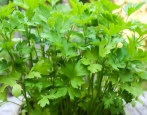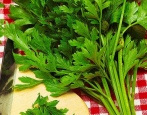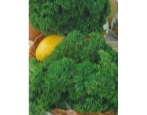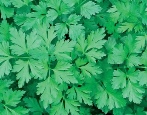
- Year of approval: 2003
- View: curly
- Leaf color: light green
- Edge waviness: strong
- Petiole: long
- Petiole thickness: thick
- Weight of one green plant, g: in open field - 30-40, in photoculture - 100-110
- Cold resistance: cold-resistant
- Average yield of greens: with year-round cultivation in photoculture (for 8 harvests) - 63.3-67.2 kg / sq. m
- Growing regions: North, North-West, Central, Volgo-Vyatka, TsChO, North Caucasian, Middle Volga, Nizhnevolzhsky, Ural, West Siberian, East Siberian, Far East
Parsley is included in the list of useful vegetable crops, through which the supply of the human body is replenished with useful vitamins, minerals and essential oils. That is why it is massively grown in all garden ridges. Among the unpretentious, fruitful and popular varieties, there is the early ripe Mooskrause parsley, which is a curly species.
Breeding history
The Mooskrause parsley is a variety with a long history. For the first time, a wild species was bred in Germany more than 100 years ago, but over time, after numerous improvements, domestications, the plant began to appear more and more often in the diet of people. The breeders of Rijk Swaan Welver GMBH worked on the process. Parsley was added to the State Register of Parsley approved for use on the territory of the Russian Federation in 2003. The vegetable is cultivated in different climatic zones.
Description of the variety
Mooskrause parsley is a fairly large plant with a semi-vertical rosette of leaves, consisting of 18-20 leaves. The height of the stem varies between 20-30 cm. The semi-sprawling plant is characterized by abundant thickening of light green foliage with wavy endings, an elongated and thick petiole, a rather thin root part of a white-gray color, 15-25 cm long, conical in shape.
During the flowering period (June-July), the plant has a single umbrella, consisting of greenish-milky or snow-white flowers. At the end of flowering, seeds are formed.
Appearance
Parsley Mooskrause stands out among its relatives with a dense crown, consisting of fleshy, juicy, shiny and velvety leaves of a beautiful shape. Outwardly, the plant resembles a beautiful ball with a wavy outline. On average, the weight of one bush is 30-40 grams, however, there are larger specimens - up to 60-110 grams. The seeds of parsley are small, bright brown in color. A characteristic feature of the variety is the rapid growth of new greens after cutting.
The cut greens are kept in the refrigerator. It is recommended to store parsley for a long time in a frozen state, which retains all its taste and useful properties. Fresh greens can be stored for 3-4 weeks in a plastic bag. Vegetable crops are well transported.
Purpose and taste
The variety is famous for its excellent taste. Despite the toughness of the greens, parsley is characterized by a bright, pronounced aroma, which provides an increased content of essential oils in the seeds. In addition, the greens have a light sweetish taste, complemented by piquant notes.
The composition of greens contains many vitamins of group B, C, E, K, choline, retinol, beta-carotene, as well as unsaturated fatty acids and minerals - manganese, selenium, phosphorus, calcium, sodium, potassium.
Parsley is widely used in cooking - it is eaten fresh, decorated with salads and sandwiches, and is also added to various dishes when stewing, boiling, and frying. In addition, parsley is frozen and dried. The culture in folk medicine is also popular.
Ripening terms
The species is early maturing. From mass germination of seeds to technical ripeness, it takes about 65-70 days.Selective cutting is carried out after the bushes grow up to 10-14 cm in height. As a rule, this is 1.5 months after planting. Harvesting takes place from late July to mid-September.
Yield
This type of parsley is quite productive. The yield depends on the cultivation method - up to 4 cuts are carried out on the garden bed, getting 2-2.5 kg of greenery from 1 m2 of plantings. When cultivating a vegetable year-round, up to 8 cuts are carried out, respectively, the yield rate is several times higher.
Growing and care
It is possible to plant greens both on the garden ridge, and all year round on the windowsill or in greenhouse conditions. Sowing seeds in the ground is carried out in late April - early May. For this, grooves are first made with a depth of 1.5-2 cm. After sowing, the beds are mulched with peat and covered with a film to accelerate the germination of seeds. During the day, the film is removed for airing for 20-30 minutes. The optimal scheme for planting is 5-7x10-15 cm.
The best predecessors for Mooskrause parsley are: cucumbers and early cabbage varieties.
The agricultural technology of vegetable crops is simple - regular watering, mulching with humus, loosening and weeding, fertilizing twice a season (superphosphates and saltpeter), as well as thinning the beds (2 times for the entire period).
Soil requirements
Parsley grows comfortably in light, fluffy, breathable, nutrient soils with moderate moisture. Fertile loamy or sandy loam soil is often suitable. Vegetable culture does not develop well in acidic substrates.
Required climatic conditions
The culture is cold-resistant, tolerates short-term drought and heat. Growing greens is recommended in sunny beds, but parsley also grows well in the shaded part of the garden.
Disease and pest resistance
The resistance to diseases and insect infestation in Mooskrause parsley is average, therefore it is necessary to follow the rules of agricultural technology.







































